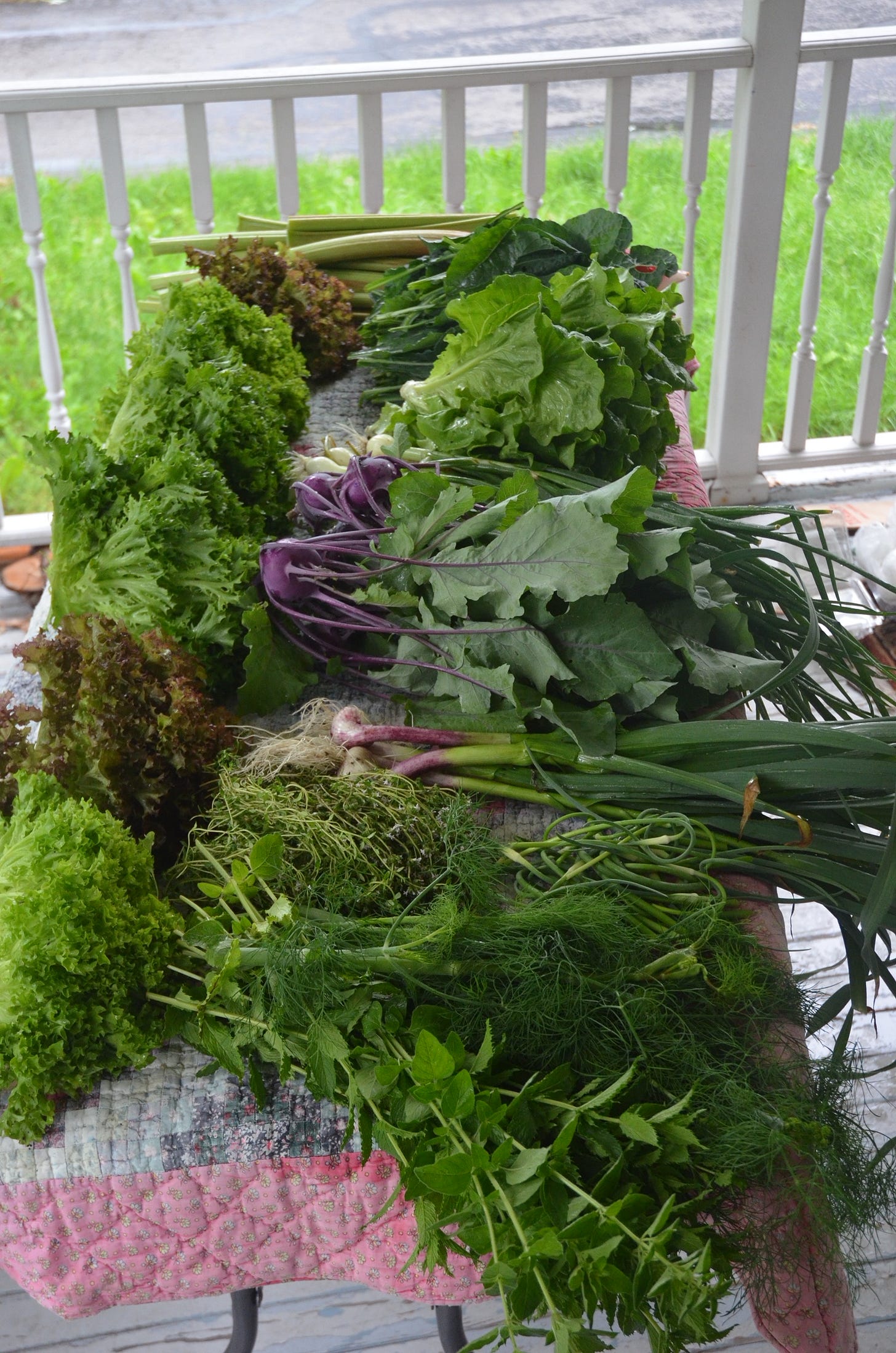Paradoxes and Dilemmas
Eating seasonally, growing your own, and looking at our food system
On the news this morning I heard an interview with Michael Pollan and Eric Schlosser about a new documentary coming out Food Inc. 2 “a fresh look at our efficient yet vulnerable food system” and I began to reflect back on a project I took on in 2013. A group of blogging friends and I took a free MIT class on food and culture. I am updating the original post with the perspective of 12 years passing in my food journey. The particular writing that I’m going back to involved four readings all with the question what are our food dilemmas now? Interestingly, the readings for the class spanned a great deal of time, from 1942 through as current as 2011. These writings can be broken into say three ‘food groups’;
diets- fads and why we are so susceptible
production- a trichotomy between mass production, crop manipulation, and hunger
culture- the significance of food through time and how it is viewed
I have found over the last several years that my focus has been firstly on learning and teaching my family about healthy food systems, and has grown into how to disseminate that information through our local community, all while knowing baby steps start at home and ripple out from there. It is alarming that as a result of how our food is produced; stripping it down one nutrient at a time, a reliance on processed foods, and a generalized lack of food sense, that our children are now expected to have shorter life spans.
Let's start with the first 'food group' ~ diets.
In Michael Pollan's article dated October 17, 2004 titled Our National Eating Disorder printed in the NY Times, he discusses multiple thoughts regarding diet over time. He begins the article and weaves throughout reflections on the almost knee-jerk reaction that people have when accepting and trying each and every new 'fad diet' out there. At the time this article was written, it was the height of low/no-carb dieting. But there are mentions of other doctor or dietitian recommended eating methods, and basically
"Americans will get behind any diet as long as it doesn't involve eating less food."
That is truly and honestly it. In this super-sized, fast, pre-packaged society that we live in it is far too easy to take the path of least resistance...especially if it is advertised as wholesome. In order to produce the most for the least our crops have been bred, fertilized, and insect repelled so much that the nutrition has been almost completely stripped from them. But hey, that is a-OK, because when these raw materials are processed, they are 'fortified' with things to reintroduce some fragment of what we have depleted. Why are we so married to the latest and greatest diet craze? I'll come back to a solution in the third 'food group'.
Update: Though my thoughts illustrated above have not wholly changed, my mind has been challenged with the circumstanses of life. In the subsequent years since I originaly wrote, my daughter struggled with anorexia. Hard in any situation, the ‘diet culture’ that our children are exposed to as early as middle school is insane. Kids are focused on body image at earlier and earlier ages, in part I believe as a result of Precocious Puberty1 which has been related to things such as hormones in our food sources 2.
An important thing I learned while she was in treatment is there is no good food or bad food, there is just food. For someone who prided myself on from scratch cooking and baking and not keeping processed foods in the house, I felt like a failure. This was a good lesson in everything in moderation.
The second 'food group' I will touch on a bit is production.
Margaret Meade's 1970 piece on The Changing Significance of Food, looks in depth at our implementation of mass production and how that made it easy for us to manufacture "on terrifying scale, foods and beverages that were guaranteed not to nourish." Once again seeing that easy and cheap ingredients can make a lot of filler disguised as 'food product' (haven't you seen that phrase on a label before)? As a striking counter balance to this wealth of efficiently used farm land and production capabilities, is the fact that there is still so much hunger all over the world, as well as here at home.
"Those who are not fed will die, or in the case of children, be permanently damaged. We must balance our population so that every child that is born can be well fed. We must cherish our land, instead of mine it, so that food produced is first related to those who need it; and we must not despoil the earth, contaminate, and pollute it in the interests of immediate gain."
This can in part begin to be accomplished by looking to and finding value in more local agriculture (small family farms) and eating a diet based more on seasonally and locally available foods.
In Mark Bittman's NY Times article A Food Manifesto of the Future, he points out several key areas that can help us begin to re-focus our priorities. "Markets-from super to farmers- should be supported when they open in so-called food deserts and when they focus on real food rather than junk food." During the research for a Co-op grocery store that we are trying to get open in our community, it was found that a large section of our town was considered a food desert. Though it includes a very wide demographic, the inner city is wholly included in it. People having good food choices in close proximity to their homes is vital in building a healthier future.
"Encourage home cooking. (Bittman says), When people cook their own food, they make better choices. When families eat together they're more stable. We should provide food education to children."
It is shocking how many children can not identify a raw vegetable!
I know that there is a major complaint out there that produce from the farmers market is not financially feasible for many families. What we have been learning since we began this journey is to look. There are many amazing foods available at very inexpensive prices. Buy in the season and put it away. If canning is too expensive (equipment is an initial investment), most things can very effectively be blanched and frozen. As an example, we bought 3 dozen ears of sweet corn from the farmers market yesterday for $7.95. This netted us 20 pts. of corn at 39 cents for 16 oz. A typical can of corn is 12.5-15 oz. This is a tremendous value for something that tastes astonishingly better than what you can buy at the store....for more money. What did we invest? An hour or so of family time to get it done...not a hardship.
Update: We spent a number of years providing food bags (a mini CSA) to friends and neighbors from our 1/3 acre garden. As we began to navigate our daughters mental illness, we did less and less in the garden, but supplemented with farmers markets and farm stands in our area. I still think the most wholesome and inexpensive way to go is eating seasonally and preserving our own food; I have also learned everything in moderation. Sometimes in life, something has to give and when time and energy has to be focused elsewhere, you can still manage to hold onto your ideals, without it consuming all of your time. This was another hard lesson; feeling like I was selling out for not being 110% comitted to the farmstead. It was during this time that I put my blogging on the shelf and turned inward. As life has normalized, we are slowly getting back into the slow food life we once dedicated all of our energy towards. This time it is just for us, and we are not thinking about large scale.
Our third 'food group' is one of the most important. It involves the culture of our food, how we eat and the importance we place on eating. Michael Pollan discusses the "French paradox". This is a fascinating concept to me and over the last year I have read a great deal on the subject. As I discussed here and here a defined food environment is where eating is about taste, savoring, enjoyment, and mostly family and friends. Portions are controlled, food is eaten slowly, snacking with the exception of the goûter (what we call ‘linner’..the little meal between lunch and dinner) is taboo, and kids are exposed to a variety of foods and expected to eat what they are served. As an experiment, we introduced the concept to the goûter3 last year and the kids were excited for it every day. This summer I let it slide a bit, and one of the first things that I heard the kids discussing with the return of school was that they would get their ‘linner’ back. Hmmm, feeling a little guilty here, but I am thrilled that it made such an impact. They eat their meals better and without complaining, and they do not snack in between (so they are hungry for their meal). Though we in the US have regional specialties and dishes, we have no defined food culture, no standards for the importance of the meal and how food is to be enjoyed over conversation and not just inhaled without tasting, so we can move onto the next event.
Update: We recently returned from a dream vacation cruising on the Rhine River. Something notable we found in Europe is that all of the portion sizes are small, yet I never left a meal feeling anything but sated. The ‘super sized’ culture of the United States is only a detriment to us all. Incredibly cheap, super processed foods in gigantic portions is not only a leading factor in obesity, for many it is the quickest, cheapest and easiest ways to manage the day to day stress in our country that does not appreciate a slower, more thoughtful approach to life. We need to find a better balance, not only in how we consume and source our food, but in how we live. This is well illustrated in Changing The Channel Kristin Powers article.
As you can see from this not so brief dissertation, that there are many dilemmas when it comes to food. I have not resolved any of them here, just pointed out some of my ongoing concerns. If we want to reverse the growing trend of shorter life-spans and earlier onset of disease, we should look closely at what and how we consume that stuff that sustains us, and maybe aspire to do it more thoughtfully.
Until Next Time!
When a child enters puberty (the process of becoming sexual mature) too early, it's called precocious puberty, or early puberty. Children experiencing the condition develop early sexual characteristics; in girls this means before age 8, and in boys, this means before age 9. Cleveland Clinic
When we eat processed foods, it changes our microbiome in negative ways. Some evidence suggests that the gut microbiota might be involved in the regulation of puberty, possibly by influencing hormones or the immune system, so it's possible that these changes could also influence the timing of puberty.Jun 1, 2023. Life Pediatric Endocrinology





